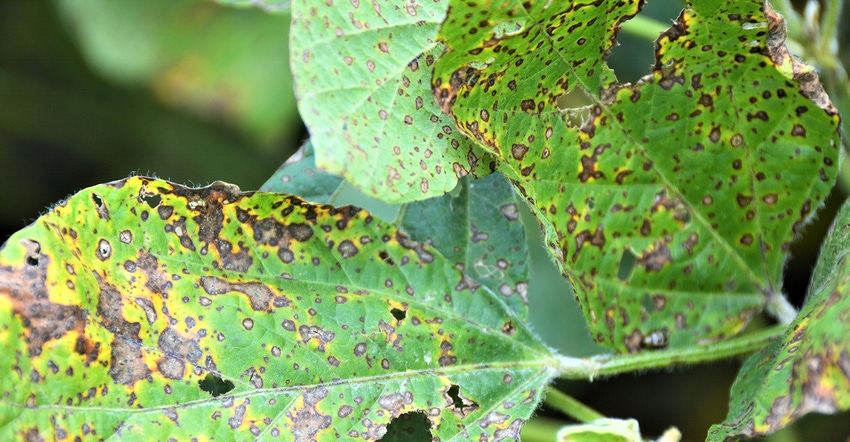April 1, 2019

There’s a new development in soybean diseases in the Dakotas.
Plant pathologists have discovered that a fungicide-resistant pathogen that causes frogeye leaf spot has been found in South Dakota.
The pathogen is Cercospora sojina. It has shown resistance to QoI fungicides (quinone outside inhibitor — strobilurin, the active ingredients in Headline and Quadris).
Febina Mathew and Emmanuel Byamukama, South Dakota State University field crop pathologist and SDSU Extension plant pathologist, respectively, detected fungicide-resistant isolates of C. sojina in fields in southeast South Dakota in 2018 after repeated application of the QoI fungicide did not control the frogeye. Isolates of C. sojina were sampled from the fields and tested for resistance at the University of Kentucky. The isolates were found to be resistant to the fungicide.
“To the best of our knowledge, this is the first report of this kind of fungicide resistance occurring in South Dakota,” Mathew says. “This finding warrants the need to determine the prevalence of QoI fungicide-resistant C. sojina isolates in the state.”
What’s frogeye?
Frogeye leaf spot is a yield-limiting disease that affects soybeans in the United States. It is predominantly managed through the use of fungicides. In 2014, frogeye leaf spot was ranked fourth among the most destructive diseases affecting soybean production in the southern United States. The disease favors extended periods of warm, wet weather during the growing season.
The most common symptom of frogeye leaf spot is angular spots with gray centers and reddish-purple outer borders on the leaves. These spots are often observed in the upper canopy, which may coincide with the prevailing environmental conditions during soybean development. Later in the growing season, under heavy disease pressure, lesions may develop on the stems and pods of soybean plants. Seeds near the lesions on the pods can be infected and appear discolored.
C. sojina resistance to QoI fungicide was first documented in Tennessee in 2010 and has been detected in several other states since then, including Iowa in 2017.
“Some growers may be wondering how the frogeye leaf spot pathogen resistance to QoI fungicide can develop [in South Dakota] even when they have not been using QoI fungicides extensively,” Byamukama says. “Because this fungus has high genetic diversity and can be spread via seed, it is possible that fungicide-resistant isolates can develop even without extensive use of QoI fungicides.”
Not every soybean field in South Dakota has QoI fungicide resistant C. sojina, but some may.
Management
Fungicide resistance can be delayed or avoided by using agronomic practices such as planting resistant varieties, crop rotation, drainage and proper soil fertility levels.
“If growers are using fungicides to manage soybean diseases, I suggest they consider three things,” Mathew says. “First, consider using pre-mixed or tank-mixed fungicides with different modes of action. Second, scout for diseases and re-apply fungicides only if needed. Third, follow manufacturer’s recommended application rates.”
Go online for more information on fungicide resistance and management.
Source: SDSU, which is solely responsible for the information provided and is wholly owned by the source. Informa Business Media and all its subsidiaries are not responsible for any of the content contained in this information asset.
You May Also Like




